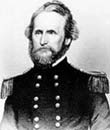
Day-by-Day Timeline of Events
May 10, 1861
Union elements take militia forces at Camp Jackson outside of St. Louis, Missouri. The action causes riots to break out.
June 15, 1861

June 17, 1861
Captain Lyon leads his victorious Union forces against opposing militia at Boonville, Missouri in what becomes the Battle of Boonville. Losses are light for both sides and helps the Union maintain control of the Missouri River.
August 10, 1861

August 30, 1861

September 2, 1861
The emancipation of Missouri slaves by Union General John C. Fremont is put down by President Lincoln. He is then reassigned.
September 5, 1861
In an effort to elevate care for the Union wounded in the Western Theater, the Western Sanitary Commission is established in St. Louis, Missouri.
October 21, 1861
Colonel Joseph Plummer leads a Union force to victory over the enemy at Frederickstown in Missouri.
November 7, 1861
The Battle of Belmont is fought on Missouri soil. It marks the first major engagement for Union General Ulysses S. Grant. A force of about 5,000 Confederates square off against 3,114 Union in Mississippi County, Missouri. It is a Confederate victory but gives Grant much-needed experience in field command.
November 7, 1861
Confederate forces, including generals Leonidas Poke and Gideon Pillow, are victorious against a Union force under the command of General Grant at Belmont, Missouri.
January 1, 1862
Union General John Schofield pens a letter to his soldiers to refrain from destruction, plunder and theft of civilian property.
February 28, 1862
The Battle of Island Number Ten (New Madrid, Missouri) begins. Union forces are led by John Pope and Andrew Footer against Confederate foes headed by John McCown and William Mackall. Six Union gunboats are aided by eleven mortar rafts, facing a Confederate force of 7,000.
March 3, 1862
General N.H. McLean in St. Louis, Missouri declares that all Confederate supporters will be hung "...as robbers and murderers..."
April 4, 1862
Gneeral John Pope's Union forces at New Madrid, Missouri, complete the construction of a canal intended to bypass Confederate firepower along the Mississippi River at Island Number Ten.
April 7, 1862
Island Number Ten along the Mississippi River, south of New Madrid, Missouri, is given up by the defending Confederate garrison.
April 8, 1862
The Battle of Island Number Ten draws to a close as the Union claims the victory. Some 7,000 Confederates surrender in the aftermath.
September 30, 1862
The First Battle of Newtonia is had in Newtonia, Missouri. 1,500 Union forces face a brigade of Indians which results in a Confederate victory.
October 28, 1862
The 79th U.S. Colored Infantry Regiment from Kansas is the first black regiment to see combat for Union forces. It is involved in clashes at Island Mounds, Missouri.
January 8, 1863
Springfield, Missouri is raided by a combined Confederate cavalry force led by General Marmaduke and Colonel Quantrill.
April 26, 1863
Union forces are successful in driving back Confederate cavalry at Cape Girardeau, Missouri.
October 13, 1863
Union troops under General E.B. Brown at Arrow Rock, Missouri, are victorious over Confederate forces led by General Joseph Shelby.
January 30, 1864
The Department of the Missouri is handed over to General Rosecrans of the Union Army.
September 19, 1864
Confederate General Sterling Price begins a series of cavalry raids into Missouri.
September 27, 1864
Fort Davidson, Missouri is the site of a Union victory over the Confederates. The victors are commanded by General Thomas Ewing. General Sterling Price leads the Confederate attackers.
October 21, 1864
The Battle of Little Blue River is recorded as a Confederate victory. General Price leas his men over General Curtis with a force of 8,500 to 2,000, respectively. The fighting takes place in Jackson County, Missouri.
October 22, 1864
The Battle of Byram's Ford is fought. Union forces are victorious in Kansas City, Missouri.The battle rages into the 23rd.
October 25, 1864
Confederate generals John Marmaduke and William Cabell are taken prisoner (along with 1,000 troops) through actions by Union General Alfred Pleasonton.
January 11, 1865
Missouri, a Union state, adopts a resolution abolishing the practice of slavery within its borders.

